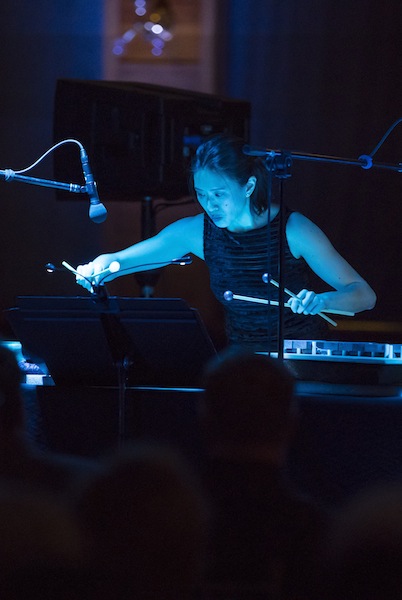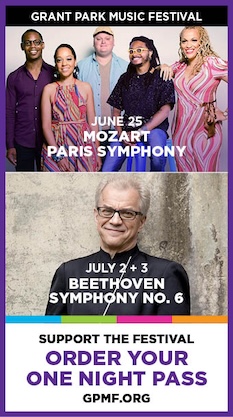MusicNOW concert blends art, American works with imaginative flair

One didn’t quite know what to expect walking into the Art Institute’s Modern Wing Monday night for the penultimate MusicNOW concert of the season. Audience members were divided into two groups and given a pink or yellow slip of paper; the program of American works were the same for each but the chronology varied with the two groups swapping venues for the first two-thirds of the evening (allowing smaller-capacity audiences to accommodate the more intimate galleries).
If the musical results were somewhat uneven, the evening was a clear success in terms of presentation. The program nicely mixed a pair of 20th-century works with music by two of today’s leading young composers. The performances took place in three striking Art Institute spaces, all of which provided engaging visual counterpoint that nicely complemented the performances.
As one of the pink card holders, I was directed to the American Sculpture Court where Neo-Classical busts and statuary provided an apt setting for the in-the-round performance of Lou Harrison’s Six Sonatas for Cembalo.
Harrison called these works “Mission-style pieces…directly stimulated by my studies about the feelings for the land, peoples, and history of California” as well as reflecting elements of Spain and Native American imagery.
Oddly, none of that is apparent in the music; the clear inspiration for Harrison’s harpsichord sonatas are those of Domenico Scarlatti (making the Italian sculptural ambiance somewhat relevant). While it was interesting to hear this rarely played music, the Six Sonatas can’t be counted among Harrison’s most timeless efforts. The sonatas display little of the composer’s eclectic individuality, sounding like less-inspired Scarlatti knockoffs, without the Italian master’s melodic invention, contrapuntal ingenuity and harmonic audacity.
Subbing for an injured Mark Shuldiner, David Schrader provided solid advocacy though one can imagine a more expressive approach making a better case for the music. Schrader’s unidentified instrument didn’t help, sounding decidedly monochrome and muted in coloring.
Next it was on to Gallery 144 where Marc Chagall’s American Windows provided the visual backdrop for music of two homegrown women composers active a century apart.
Ruth Crawford Seeger (1901-53) didn’t live up to the promise of her early experimental music and her output is rather circumscribed, reflecting her turn away from composition to teaching and making arrangements of American folk music.
But Seeger’s String Quartet 1931 is a remarkable work, like no American music of the period and sounding startlingly modern even today. Seeger crafted her 11-minute quartet in a unique brand of modified serialism, with themes emerging through single pitches from each instrument. This is not an easy work to pull off successfully, yet the strong performance Monday night by violinists Matous Michal and Hermine Gagne, violist Danny Lai (all CSO members) and cellist Calum Cook provided supreme advocacy. The players brought bracing clarity to Seeger’s dense textures and knotty counterpoint, with Michal especially fine in the jabbing, Bartokian violin solo of the final movement.
The youngest winner of a Pulitzer Prize in music, Caroline Shaw was represented with her Blueprint for string quartet. This seven-minute romp is cast in cast in Shaw’s lighter vein, yet none the worse for its lack of angst. Here too the players made the most of Shaw’s well-crafted score, conveying its mercurial esprit, galumphing energy, pizzicato dances and jokey Beethoven-like coda.
Both audience divisions gathered in the (replicated) Chicago Stock Exchange Trading Room for the final event of this moveable musical feast, Christopher Cerrone’s Memory Palace.
Like Shaw, Cerrone has been earning widespread accolades in recent years. His Goldbeater’s Skin upstaged the Ligeti works at a Logan Center concert in February and Cerrone’s music was recently spotlighted in the Miller Theatre’s Composer Portrait series in New York.
Cerrone has concentrated on writing percussion music where he has shown a clear gift for utilizing techniques and instrumental effects that often sound gimmicky in lesser hands.
Memory Palace, performed by CSO principal percussionist Cynthia Yeh, uses electronics that employ Cerrone’s personal recordings of places that meant much to him in his life. Yet there is also a highly interactive element with the performer called upon to choose and fashion her own found instruments.
The work is cyclical, beginning with what sounds like the surface noise of an LP leading to the soloist playing a nostalgic rising theme on crotales against a warm, undulating electronic underlay. A sudden thunderous kick-drum crash leads to a section with driving, intense rhythms, followed by more delicate shimmering colors; the work concluded with Yeh coaxing unearthly sounds by blowing into the tops of a variety of liquor bottles.
Yet somehow it all works, evoking a broader sense of uneasy solace and retrospective nostalgia in a surprisingly compelling and affecting fashion. That’s a testament to Cerrone’s compositional gifts as well as the hard-working Yeh, who provided a boldly projected yet sensitive and resourceful performance.
Kudos to MusicNOW presenters, composers Elizabeth Ogonek and Samuel Adams, for this clever programming venture and for the staffs of the CSO and Art Institute for pulling it off so capably. MusicNOW may want to consider making this Art Institute collaboration a regular part of its annual series.
MusicNOW concludes its 20th anniversary season with Esa-Pekka Salonen leading a concert 7 p.m. May 21 at Symphony Center. The program includes Magnus Lindberg’s Related Rocks, Anna Thorvaldsdóttir’s Ró, and the world premieres of Elizabeth Ogonek’s The Water Cantos [notes from quiet places] and Samuel Adams’ Chamber Concerto. cso.org; 312-294-3000.
Posted in Uncategorized



Posted May 10, 2018 at 7:34 am by Clark Costen
The pre-recorded lead in to Memory Palace was not “surface noise of an LP”, but rather the soothing, evocative sound of crickets and katydids on a warm summer night!